Summary
-
As the name implies, Fusarium wilt of queen palm and Mexican fan palm is primarily observed on Syagrus romanzoffiana (queen palm) and Washingtonia robusta (Mexican fan palm or Washington palm). When this disease first appeared, it was called "Fusarium decline." That disease name is no longer valid.
-
The disease is caused by the fungus Fusarium oxysporum f. sp. palmarum.
-
This disease is similar to Fusarium wilt of Canary Island date palm, but the pathogen subspecies and host range are different.
-
The leaf symptoms include a one-sided chlorosis (yellowing) or necrosis (brown due to death) of the leaf blades, with a distinct reddish brown or dark brown stripe on the petiole and rachis. The internal petiole and rachis tissue is discolored. Eventually, the entire leaf dies.
-
The disease symptoms normally appear first on the oldest (lowest) living leaves, and then progressively move upward in the canopy until the palm is killed. Palms often die quickly, within two to three months after initial symptoms are observed. Due to the quick decline, the necrotic leaves do not necessarily droop or break and bend down around the trunk, but remain relatively rigid.
-
The only other disease that the leaf symptoms could be confused with is petiole (rachis) blight.
-
It is not known exactly how the fungus spreads so widely in the landscape, but wind-blown spores are strongly suspected as a primary method. Local transmission of the fungus from palm to palm is possibly caused by contaminated pruning tools.
-
There currently is no cure for this lethal disease.
-
Laboratory confirmation of this Fusarium wilt pathogen requires molecular techniques.
Introduction
Fusarium wilt is very host specific, with the primary hosts being Syagrus romanzoffiana (queen palm) and Washingtonia robusta (Mexican fan palm or Washington palm). It is caused by Fusarium oxysporum f. sp. palmarum. When this disease was first observed, it was referred to as "Fusarium decline." However, now that the exact pathogen is known, the more correct disease name is "Fusarium wilt." The full name of "Fusarium wilt of queen palm and Mexican fan palm" was given to this disease to distinguish it from the other Fusarium wilt disease that occurs on a palm in Florida, Fusarium wilt of Canary Island date palm (https://edis.ifas.ufl.edu/pp139). This disease primarily occurs on Phoenix canariensis, and is caused by F. oxysporum f. sp. canariensis (note the different subspecies name).
Pathogen and Hosts
Fusarium wilt of queen palm and Mexican fan palm is caused by the fungus F. oxysporum f. sp. palmarum. The fungus causes a vascular wilt of the palm. Specifically, it obstructs the xylem (water-conducting) tissue, which results in the symptoms of leaf desiccation and death described below.
The fungus produces short-lived spores (macroconidia and microconidia). It also produces spores called chlamydospores that live in the soil and plant tissue for long time periods (usually years).
The primary hosts of the pathogen are Syagrus romanzoffiana (queen palm) and Washingtonia robusta (Mexican fan palm or Washington palm). While the pathogen has also been observed affecting Canary Island date palm and the "mule" palm (× Butyagrus nabonnandii), a cross between Syagrus romanzoffiana and Butia odorata, this has occurred very rarely.
Thus far, the disease has been documented in Florida and the Houston-Galveston area of Texas. It is widespread throughout Florida. Affected palm trees have been observed mostly in mature landscapes. However, the disease has been observed on juvenile palms (palms without trunks) in a few nurseries. Because the diseased palms decline so quickly, the diseased nursery palms are often not marketable.
Symptoms
As with most diseases, Fusarium wilt symptoms are progressive. For queen palms, there will be at least one leaf with some or all leaflets discolored on only one side of the rachis. The leaflets will be either chlorotic (shades of yellow) or, more often, a shade of brown due to desiccation or death. The leaflets on the opposite side of the rachis will be a healthy green color (Figures 1 and 2). This very distinctive symptom is often referred to as "one-sided wilt" or "one-sided death." A reddish brown or dark brown stripe will be visible on the petiole and rachis of the affected frond, on the same side where the first dead leaflets appear. This streak may run the full length of the petiole and rachis, or just a portion of it. Internal discoloration will be observed in cross sections of the discolored petiole and rachis (Figure 3). Eventually, the leaflets on the other side of the rachis will turn brown and the entire leaf will die.
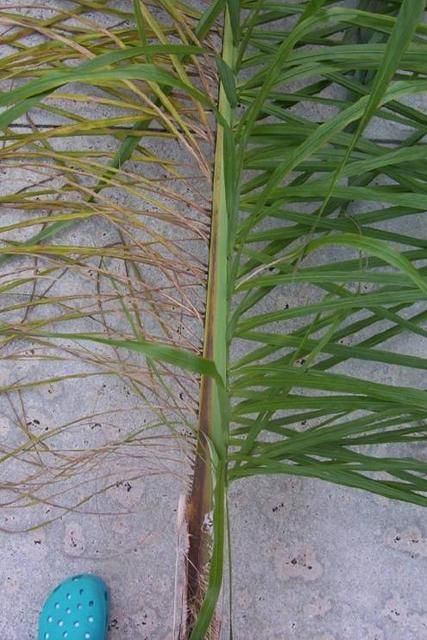
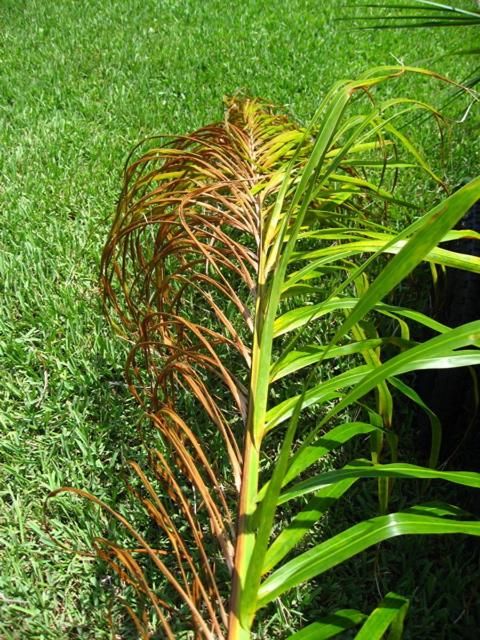
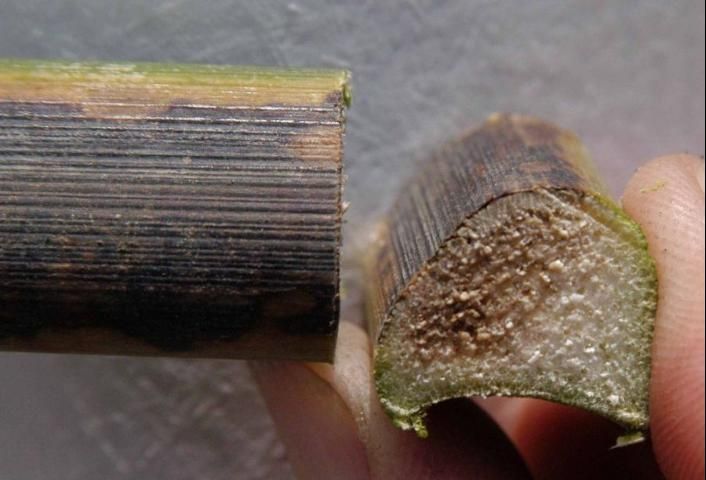
For Mexican fan palms, there will be at least one older leaf with a mixture of healthy, chlorotic, and necrotic leaflet segments in the leaf blade. As with the queen palm, there will be a reddish brown or dark brown stripe on the petiole, with a corresponding internal discoloration in the cross section (Figure 4).
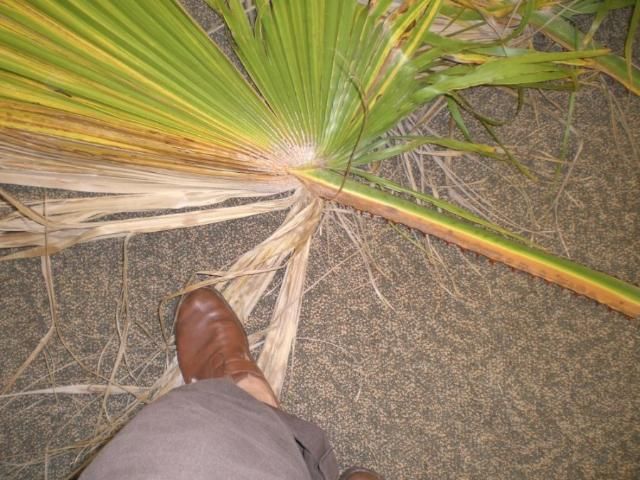
For both hosts, the disease symptoms normally begin on the lowest (oldest) leaves and move up the canopy, progressively killing younger and younger leaves. The spear leaf is the last leaf to die. Death from Fusarium wilt occurs very quickly, with palms often dying within two to three months after initial symptom development. Due to the quick decline, a very characteristic symptom of this disease is the overall canopy appearance. The necrotic leaves do not droop or break and bend down around the trunk, but remain relatively rigid (Figures 5, 6, and 7).

Credit: Reproduced by permission of Brooke Burn, UF/IFAS Extension
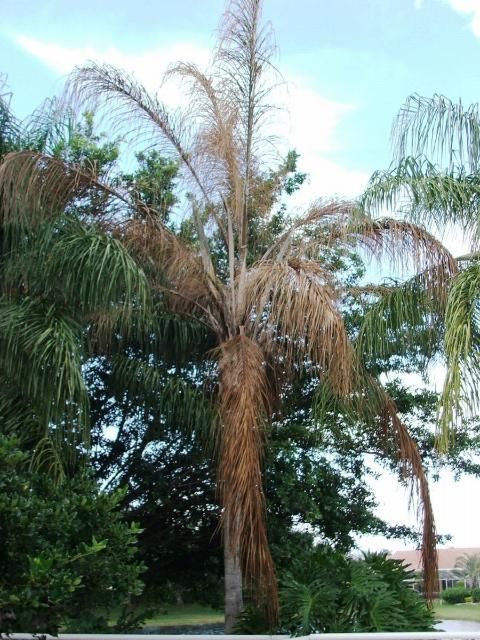
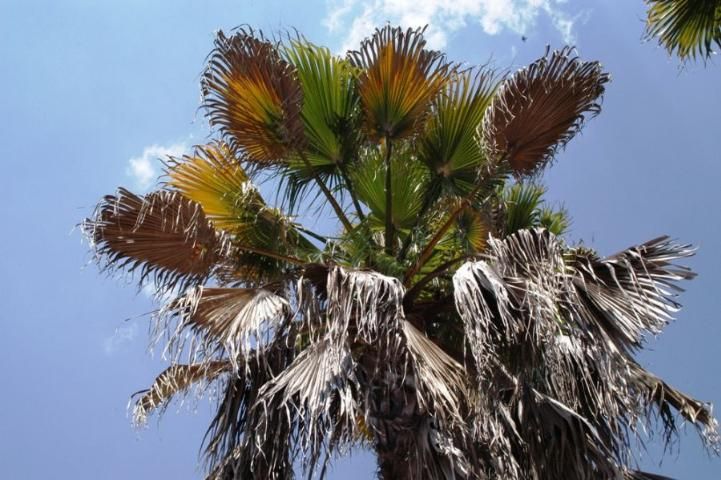
Diagnosis
The initial field diagnosis can often be made based on the symptoms described above, especially if the symptoms are typical. No other fungal disease kills the entire palm canopy so quickly. In fact, if the disease is progressing very quickly, there may only be one leaf with typical symptoms because the leaves are dying so rapidly. However, the initial symptoms of Fusarium wilt look exactly like the symptoms of petiole (rachis) blight (https://edis.ifas.ufl.edu/pp145), especially in Mexican fan palms. The latter disease is not a true vascular wilt, but the resulting leaf symptoms of petiole (rachis) blight are the same as Fusarium wilt. However, palms seldom die from petiole (rachis) blight. Therefore, it is essential to confirm which disease is affecting the palm with a laboratory test.
Another disease that can kill queen palms is Texas Phoenix palm decline (https://edis.ifas.ufl.edu/pp163). However, the spear leaf (the youngest leaf that has not expanded) dies very early in the disease process if Texas Phoenix palm decline is the problem, whereas the spear leaf is the last leaf to die if Fusarium wilt is the problem.
Ganoderma butt rot (https://edis.ifas.ufl.edu/pp100) will cause palm canopies to die from the bottom to the top, but this is usually a slower process than what is observed in Fusarium wilt, and the canopy will not include leaves with the one-sided death typical of Fusarium wilt.
To confirm the field diagnosis, a laboratory must isolate the pathogen from the affected leaf tissue and then conduct a molecular test on the isolated culture. There are numerous F. oxysporum isolates that do not cause disease, but that are still associated with palm material. Unfortunately, it is not possible to separate pathogenic isolates from nonpathogenic isolates based on their appearance in culture. Thus, isolation of a fungus that looks like F. oxysporum does not confirm the field diagnosis. The fungus growing on the culture plate is then subjected to a molecular test that can confirm if the fungus is F. oxysporum f. sp. palmarum.
Contact your local UF/IFAS Extension office (http://solutionsforyourlife.ufl.edu/map/index.html) or the UF/IFAS Plant Diagnostic Clinic (http://plantpath.ifas.ufl.edu/extension/plant-diagnostic-center/) for complete details on correct sample submission procedures and cost of a laboratory diagnosis. The best leaf to sample is one where half the leaf is still green and the distinctive reddish brown or dark brown stripe is present on the petiole/rachis (see Figures 1, 2, and 4), and where there is internal discoloration of the petiole/rachis (see Figure 3). Do not place the leaf in plastic. Place the sample in a paper bag for hand delivery or a cardboard box for shipping.
Disease Management
Once the palm is affected by this disease, there is no cure. Currently, there is no method for preventing this disease, either. Based on observations in Florida, the pathogen appears to be spread primarily by airborne spores (conidia) moved by wind, and possibly birds or insects.
Once the disease is established in a landscape or nursery, it is thought that the disease may be transmitted from palm to palm via leaf-pruning equipment. The fungal pathogen is located in the vascular tissue of the leaf. Equipment used to remove leaves from an infected queen palm or Mexican fan palm (chain saw, lopper, pruning shear, hand saw, etc.) will have fungus-infested leaf material (wood dust, plant sap) remaining on the blades. If equipment is not cleaned and disinfected, the next queen palm or Mexican fan palm pruned by this equipment will be exposed to fungus-infested leaf material. It is important to note that a palm could be infected but appear healthy (symptomless) because the disease has not developed to the point that leaf symptoms are being expressed.
Pruning should be restricted to removal of dead or dying leaves only. Severe pruning weakens palms and may increase the risk of pathogen transmission. Pruning should be viewed as a risk factor for Fusarium wilt disease transmission and not as a benefit to the palm.
Table 1 provides a list of suggested materials that can be used as disinfecting agents. Brush the tool blades clean of debris before placing in the disinfectant solution. For chain saws, it is recommended that they be taken apart and both the chain and bar soaked. By using multiple pruning tools, one tool can be soaking in the disinfectant solution while the other tool is used for pruning. The disinfectant solution should be replaced at least every 10 trees or every 2 hours. Rinse tools with clean water before pruning.
Again, this is a disease without a cure. In a nursery situation, diagnosis of this disease effectively destroys the crop, as the plants are not marketable and must be destroyed. In a landscape situation, the palm will eventually die and have to be removed. In both situations, the diseased palm(s) should be removed and destroyed immediately.
As long as the disease is restricted to the canopy and has not moved into the trunk, only the diseased canopy should be incinerated, placed in a landfill or composted properly. If this is not possible (as is the case in many Florida counties), then be sure the palm canopy is not chipped for mulch in the landscape. Chain saws and other tools used for removal must be brushed free of plant material and disinfected as described previously. If the trunk is clean (no signs of discoloration), it could be chipped and recycled as mulch. Stumps should be ground or removed to prevent colonization by the fungus that causes Ganoderma butt rot (https://edis.ifas.ufl.edu/pp100).
Based on other Fusarium wilt diseases of palms, it is recommended that a queen palm or Mexican fan palm not be planted back into a site where one of these species has died from Fusarium wilt.
Selected References
Elliott, M. L. 2012. "First report of Fusarium wilt caused by Fusarium oxysporum f. sp. palmarum on Canary Island date palm in Florida". Plant Disease 96:356. https://doi.org/10.32473/edis-pp139-2012
Elliott, M. L., E. A. Des Jardin, C. L. Harmon, and S. Bec. 2017. "Confirmation of Fusarium Wilt Caused by Fusarium oxysporum f. sp. palmarum on × Butyagrus nabonnandii (mule palm) in Florida". Plant Disease 101:2. https://doi.org/10.1094/PDIS-08-16-1099-PDN
Elliott, M. L., E. A. Des Jardin, K. O'Donnell, D. M. Geiser, N. A. Harrison, and T. K. Broschat. 2010. "Fusarium oxysporum f. sp. palmarum, a novel forma specialis causing a lethal disease of Syagrus romanzoffiana and Washingtonia robusta in Florida." Plant Disease 94:31–38. https://doi.org/10.1094/PDIS-94-1-0031
Giesbrecht, M. M. McCarthy, M. L. Elliott, and K. L. Ong. 2013. "First report of Fusarium oxysporum f. sp. palmarum in Texas causing Fusarium wilt of Washingtonia robusta." Plant Disease 97:11. https://doi.org/10.1094/PDIS-05-13-0488-PDN
Simone, G. W. 1998. Prevention and management of palm diseases in Florida's landscapes. Plant Pathology Mimeo 98-4. Gainesville: University of Florida Institute of Food and Agricultural Sciences.
Smith, D. I., I. W. Smith, and P. Clements. 2003. Fusarium wilt of Canary Island date palm. Forests Fact Sheet. Victoria, Australia: Department of Sustainability and Environment.